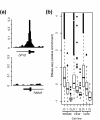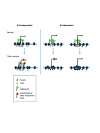H3K4me3 inversely correlates with DNA methylation at a large class of non-CpG-island-containing start sites
- PMID: 22640407
- PMCID: PMC3506913
- DOI: 10.1186/gm346
H3K4me3 inversely correlates with DNA methylation at a large class of non-CpG-island-containing start sites
Abstract
Background: In addition to mutations, epigenetic silencing of genes has been recognized as a fundamental mechanism that promotes human carcinogenesis. To date, characterization of epigenetic gene silencing has largely focused on genes in which silencing is mediated by hypermethylation of promoter-associated CpG islands, associated with loss of the H3K4me3 chromatin mark. Far less is known about promoters lacking CpG-islands or genes that are repressed by alternative mechanisms.
Methods: We performed integrative ChIP-chip, DNase-seq, and global gene expression analyses in colon cancer cells and normal colon mucosa to characterize chromatin features of both CpG-rich and CpG-poor promoters of genes that undergo silencing in colon cancer.
Results: Epigenetically repressed genes in colon cancer separate into two classes based on retention or loss of H3K4me3 at transcription start sites. Quantitatively, of transcriptionally repressed genes that lose H3K4me3 in colon cancer (K4-dependent genes), a large fraction actually lacks CpG islands. Nonetheless, similar to CpG-island containing genes, cytosines located near the start sites of K4-dependent genes become DNA hypermethylated, and repressed K4-dependent genes can be reactivated with 5-azacytidine. Moreover, we also show that when the H3K4me3 mark is retained, silencing of CpG island-associated genes can proceed through an alternative mechanism in which repressive chromatin marks are recruited.
Conclusions: H3K4me3 equally protects from DNA methylation at both CpG-island and non-CpG island start sites in colon cancer. Moreover, the results suggest that CpG-rich genes repressed by loss of H3K4me3 and DNA methylation represent special instances of a more general epigenetic mechanism of gene silencing, one in which gene silencing is mediated by loss of H3K4me3 and methylation of non-CpG island promoter-associated cytosines.
Figures






References
Grants and funding
LinkOut - more resources
Full Text Sources

